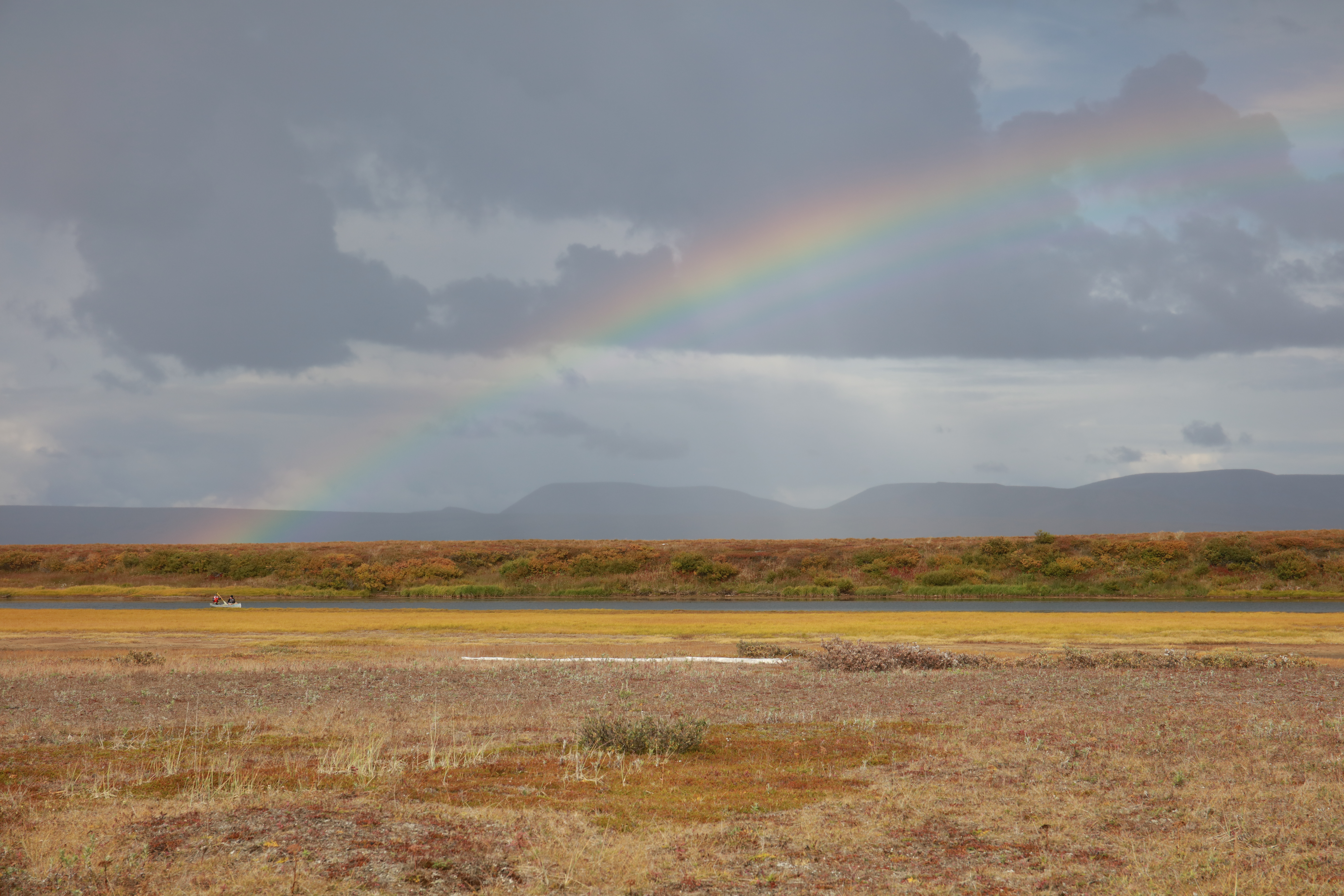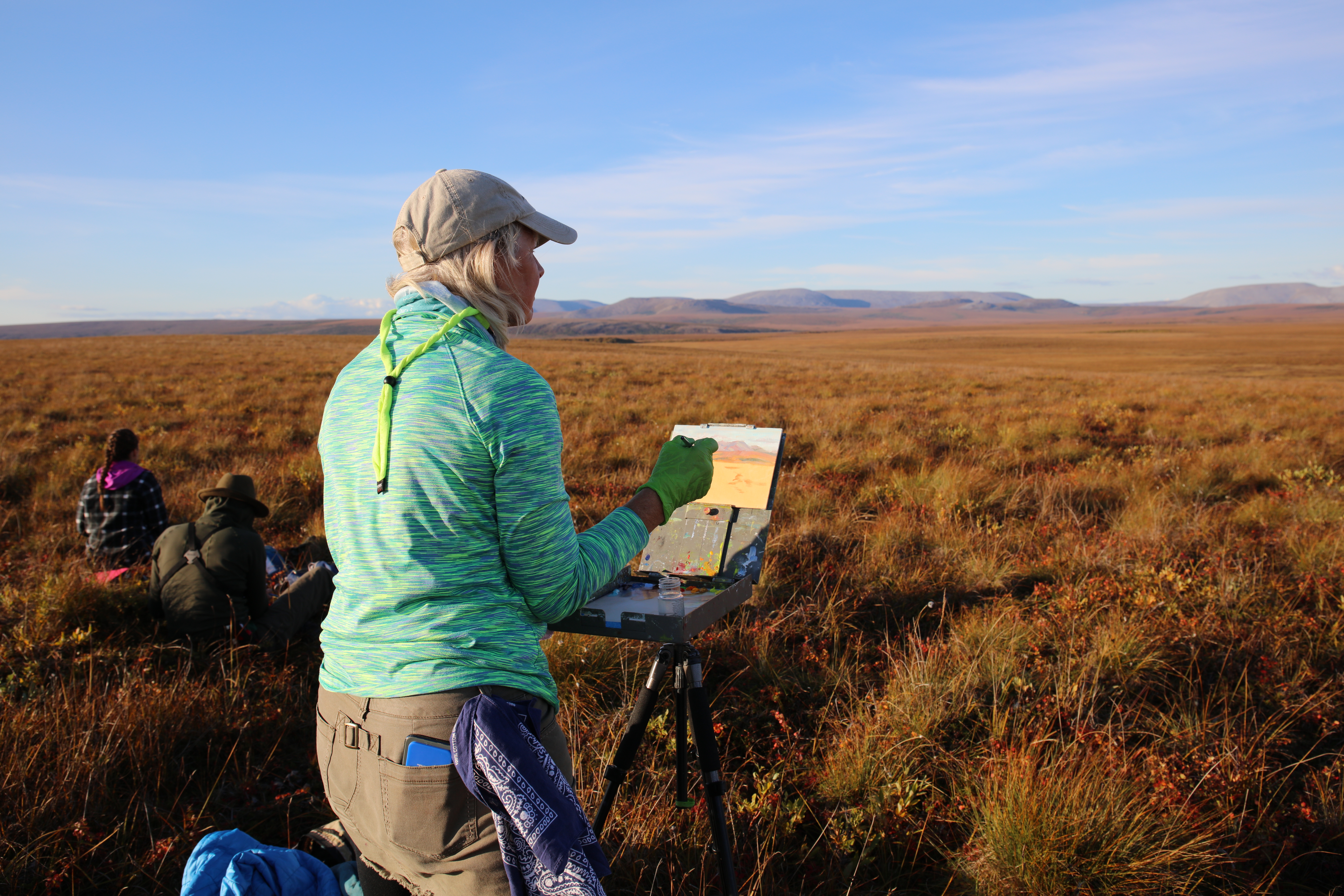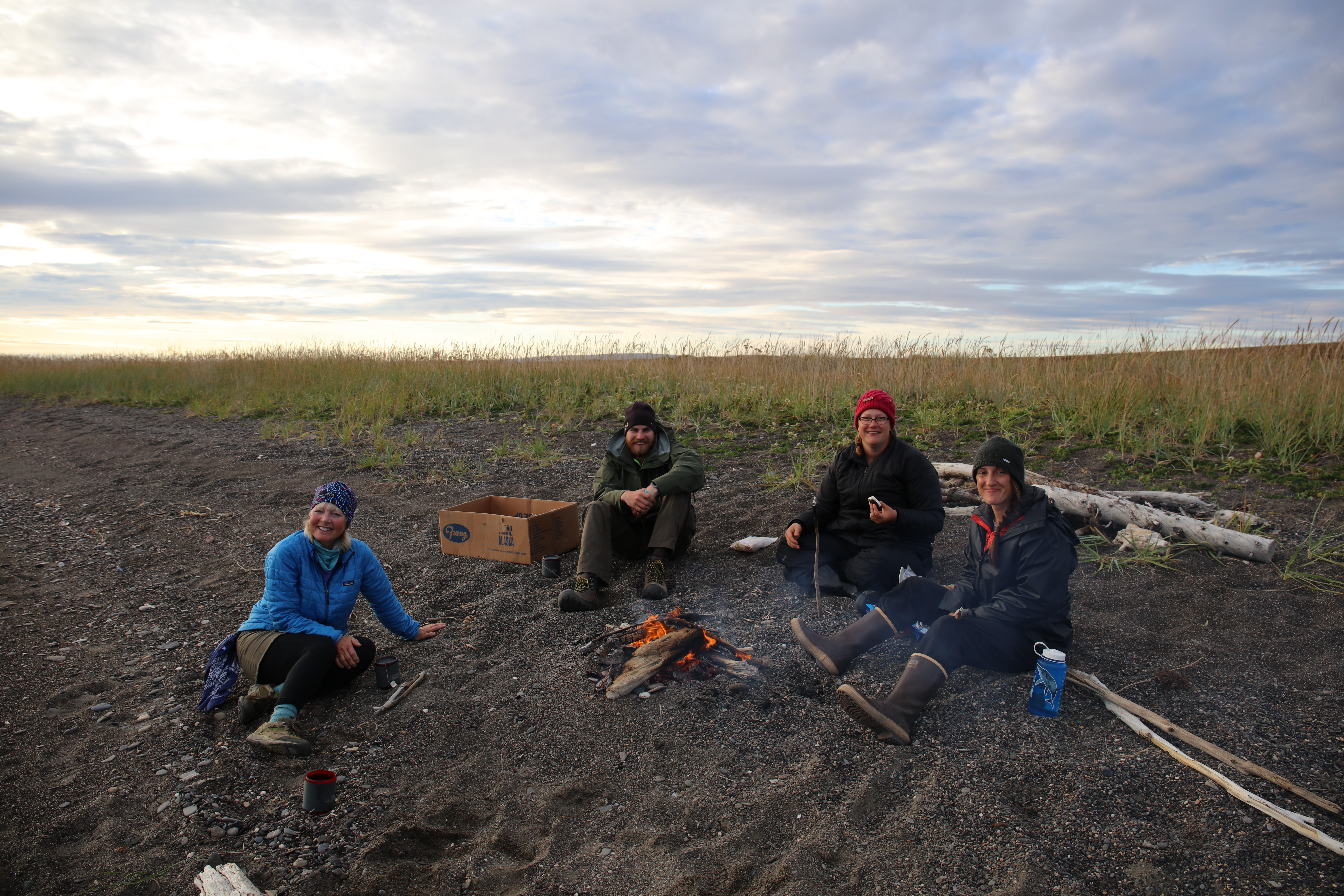There were seven of us all together, barely speaking in the cold, except to occasionally comment on our excitement for the trip or to wonder if the clouds were going to break for us. The group consisted of four Interpretation Rangers (Tyler, Deanna, Clare, and me), Ed and Alfred, who were our captain and first mate on the boat, and Pam, our Artist-in-Residence. Ed and Alfred watched the water, focused on avoiding sandbars and discussing the best route to Anigaaq since the usual river outlet was closed off. Pam brought genuine fascination and awe with her, excited even in the rain, marveling at the adventure we were embarking on. As we neared Anigaaq, the clouds began to lift. We were greeted with a rainbow on our arrival. Rainbows would become a symbol of our trip, appearing suddenly throughout it as if just popping in to say hello.

We searched the beach for shells, mammoth ivory, and fossils if we could find them. The sea is constantly depositing new treasures and sweeping old ones away as it erodes the shoreline. Anigaaq is part of Cape Krusenstern National Monument, and people have lived and subsisted here for thousands of years – and still do today. Visitors aren’t permitted to take any artifacts they find, but it’s exciting to search for them anyway. History abounds everywhere you look.
Once again, we climbed up the tundra and began to snack on berries. There was not a single place you could step where you wouldn’t squish an akpik, smush a blueberry, or smoosh a crowberry. We picked a few and headed back to camp. The real exploring would begin tomorrow.
Each day brought us an abundance of mini-adventures.
On Tuesday, we anticipated more rain, but we found ourselves lucky and the weather system avoided us. Pam had previously done a fly over of the area with a local friend and spotted some whale ribs she wanted to paint, so we set that as our destination for the day.
Whale bones are often used as grave markers, especially for the graves of whaling captains or people of special importance. Bright green tundra grasses grew between them, contrasting the autumn yellow, reds, and muted greens of the surrounding tundra plants. Vibrant fireweed bloomed in front of one rib. Pam began painting while the clouds played above us. She commented on how difficult it was to capture a scene when the lighting and cloud patterns were constantly changing. While the promised rainstorm never hit us, a rainbow still spread across the sky over the tundra behind the whale ribs.

After retrieving the canoe with Tyler, we headed back to the group. Deanna joined us to see what we could find from one of the tundra hills. The mudflats stretched below us and we saw several little lakes, a few cabins, and – just barely – the Anigaaq Lagoon in the distance. We scanned for more caribou, muskoxen, and bears (always scan for bears!) but nothing revealed itself to us.
Wednesday brought us a muskoxen sighting! A lone muskox lumbered toward our camp after dinner. It watched us warily from a ways off, unsure of whether to continue toward these suspicious figures in the distance or turn back. It turned into a patch of willows, using the branches as its personal scratching post. We crouched in front of the cabin, watching it through binoculars and whispering in excitement. The muskox must have decided we weren’t to be trusted and eventually turned away from our camp.
After the excitement waned, Clare and I left camp to search for wild celery. Clare was searching for the perfect wild celery plant to film. Wild celery, or angelica lucida, is a medicinal plant whose root, though toxic when ingested, can be used externally to treat cuts and infections. Since there were fewer opportunities to share this type of knowledge in person because of Covid-19, being able to create digital content helped our park rangers reconnect with one of the reasons many rangers are drawn to Interpretation in the first place – connecting people to the fascinating history, culture and nature of our public lands.
Later, the team hiked back to a spot Clare, Deanna, and I discovered earlier in the day during our filming and photography excursion. We thought the site was so beautiful; we had to bring Pam to see it to paint. We sat atop a tundra hill, overlooking a river winding through the valley and marveling at the gentle mountains in the distance. As Pam painted, we decided to have an art session of our own. We drew quilt squares in colored pencil, trying to capture the character of Anigaaq and the trip. In three days, I had seen half a dozen rainbows, picked berries, learned to catch salmon and whitefish (setting a net and fileting fish was a new experience for me), and spent more time on the tundra than I had in the last two months combined. And there was still so much more to see.

No matter how many times I set foot on the tundra, I am always overtaken by feelings of both wonder and glee. The tundra can go on for miles. It gives me the same feeling I get when I look out at a body of water with no shore in sight or across farmland that extends until it touches the horizon. The tundra rolls on and on, eventually greeting the mountains in the distance. In the fall, it is streaked with golden grasses, green and purple berry leaves, red dwarf birch, and blazes of yellow willows.
Lichen, moss, and the topsoil above the permafrost give the tundra a texture that is hard to describe. Think of the last time you jumped on a trampoline. Or the way it feels when your boot sinks into thick mud that you thought was solid ground. Or maybe imagine the way bread dough feels when it is ready to be baked – you can press a knuckle into it, and it gives, but then gently retakes its original shape. None of these are perfect descriptions of the tundra; it is some combination of each experience. That is what makes it all the more fun to walk (and trip and stumble) across. Tussocks look like grass-covered boulders scattered across the landscape, but they’re actually a sedge (“cottongrass”) that clumps closely together. This, paired with uneven layers of permafrost, leads to winding and treacherous walking paths along the tundra. You can choose to walk in the divots and pinball between the tussocks or hop from tuft to tuft and risk tumbling off one.
Sitting out on the tundra with my team that evening – investigating the tiny villages of lichen, dwarf birch, mushrooms, and moss, and feeling awestruck at the expanse of wilderness that surrounded me – will stick with me for years. Pam finished her painting as sunset neared (though it would last for several hours) and we headed back to camp for the night.
On Thursday, Deanna joined me in a canoe adventure, searching for a bear skeleton Tyler and Pam had found the previous day. Even though they gave us directions, we still spent a couple hours paddling around a small inlet, convinced we were on the wrong path. We paddled around, checking each tiny tributary to see if we could get through. Met with dead end after dead end. We stopped for lunch (and more berry picking for dessert) and discussed our next course of action. Deanna suggested we go back to the first turn off point we found. Try it one more time. I was skeptical – there wasn’t anything to see there – but agreed. Afterall, what harm could it do?
This portion of the river was shallow and filled with aquatic grasses that tugged at our paddles as we tried to maneuver. We edged the canoe closer to canal, which we determined to be too narrow and shallow to paddle through earlier. It appeared just as closed off as before. Surely, we would get stuck. I was ready to give up, dig my paddle into the muck and turn around, when Deanna spotted the skeleton. Just off to the side. In plain sight. Splayed out on the mudflat.
I think spending so much time looking for it in the wrong places made me even more ecstatic to finally find it after all. We had to get closer. Canoe pulled ashore, gloves on, boots ready to be sacrificed to the muck, we approached the skeleton to investigate. In all my exploring, tromping through woods and wetlands, I had never seen a complete skeleton. I certainly had never seen a bear skeleton, of all things, with some fur still inexplicably sticking to its bones. We moved on to see what else we could find. The flats appeared to be a nesting ground for birds earlier in the year, as we discovered some leftover eggs nearby. Old wolf and bear tracks crisscrossed the flats and we meandered with them briefly. There was so much evidence of the wildlife that roams the tundra unseen.
Our canoe-venture a success, Deanna and I paddled back to the group. The team had a dinner to eat, a campfire to build, and paintings to admire before we prepared to head home the following morning. I had trouble comprehending just how quick our trip had come to an end.

Although we had the same base camp, the Anigaaq Ranger Station, and never wandered more than a few miles from it, each day led to a new discovery. Maybe it’s because the whole experience was novel to me, but I found the most joy in the smallest moments. Splashing in the waves on the shore of Chukchi Sea, delighted by the cold water. Balancing on treacherous tussocks. Seeing the ghostly northern lights for the first time, so faint that I wasn’t sure what they were. And I am always, always in love with the autumn arctic landscape.

